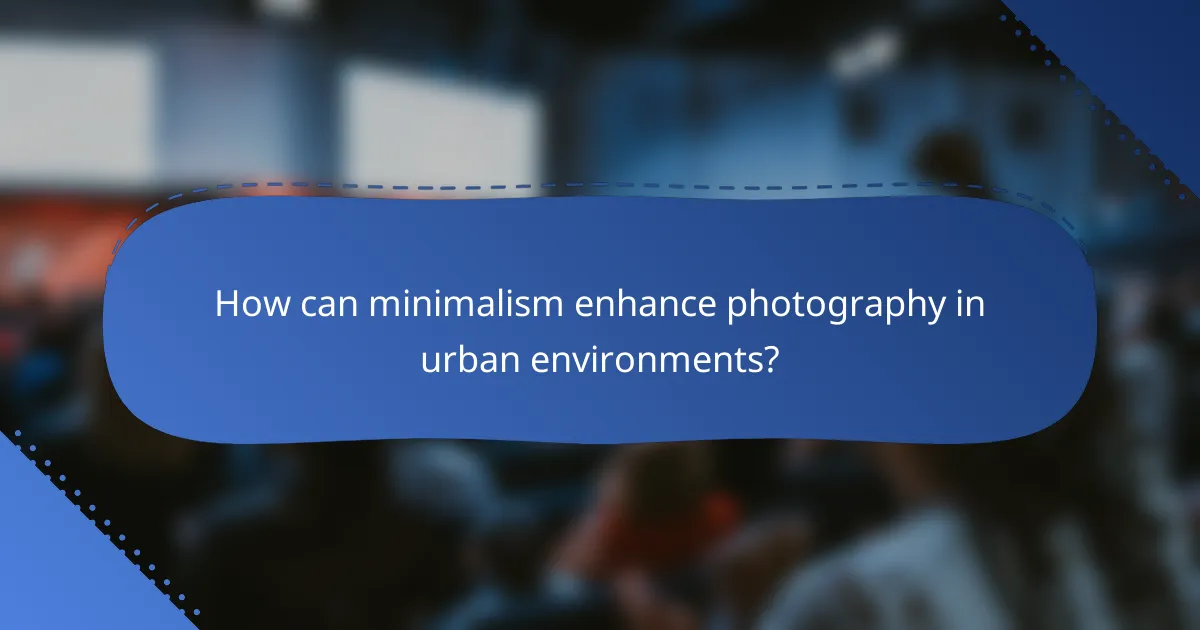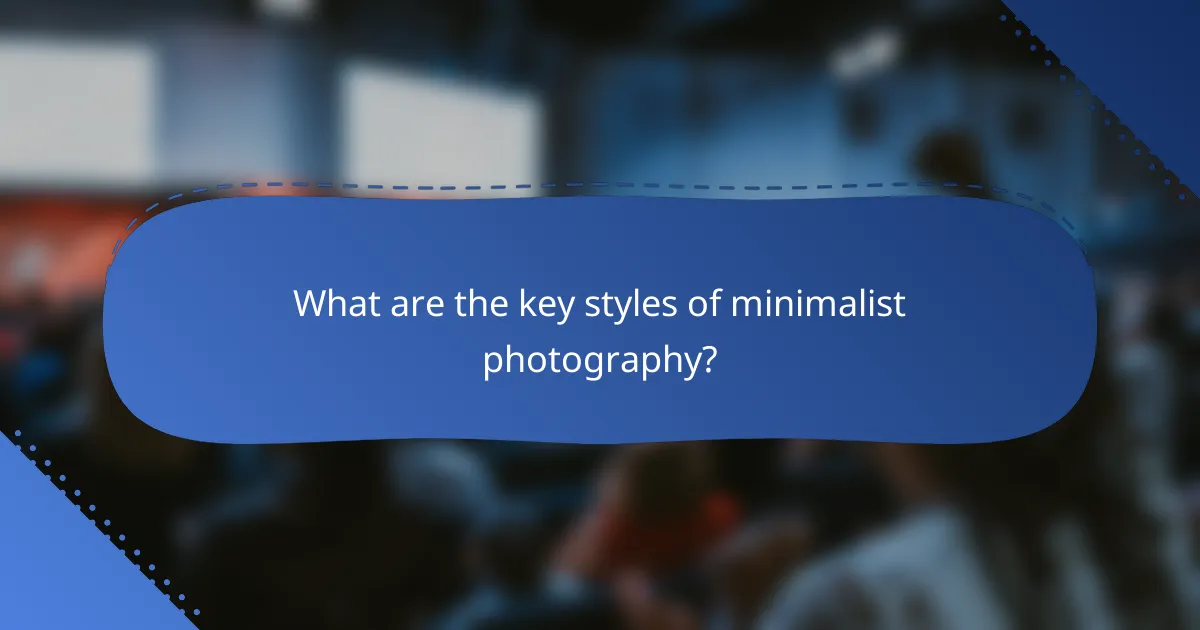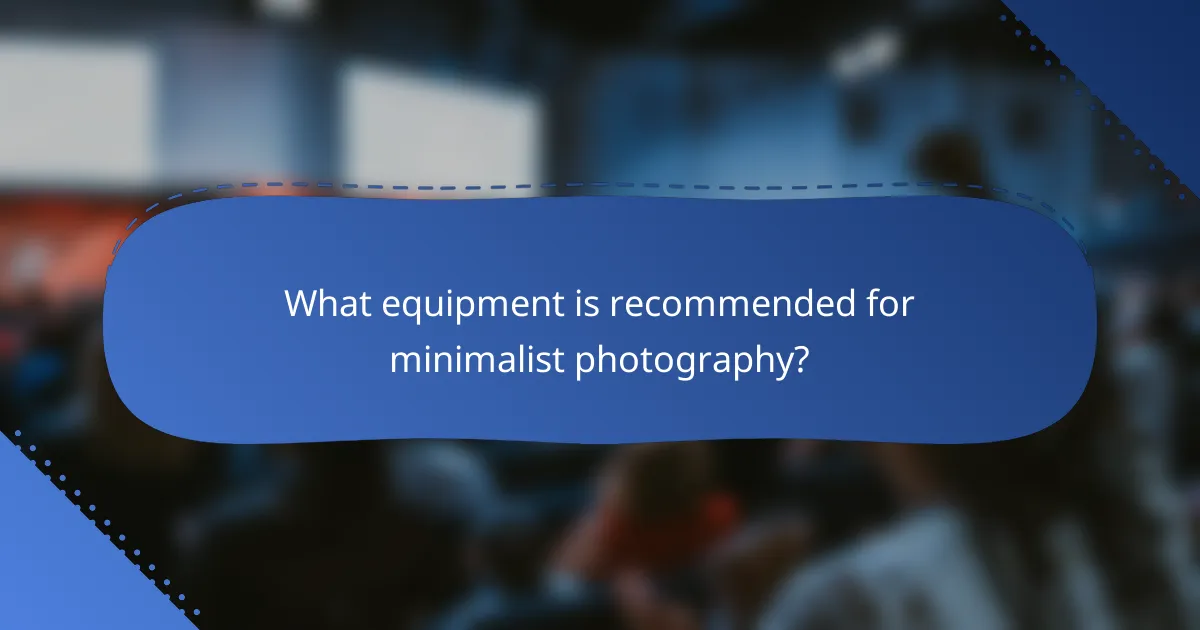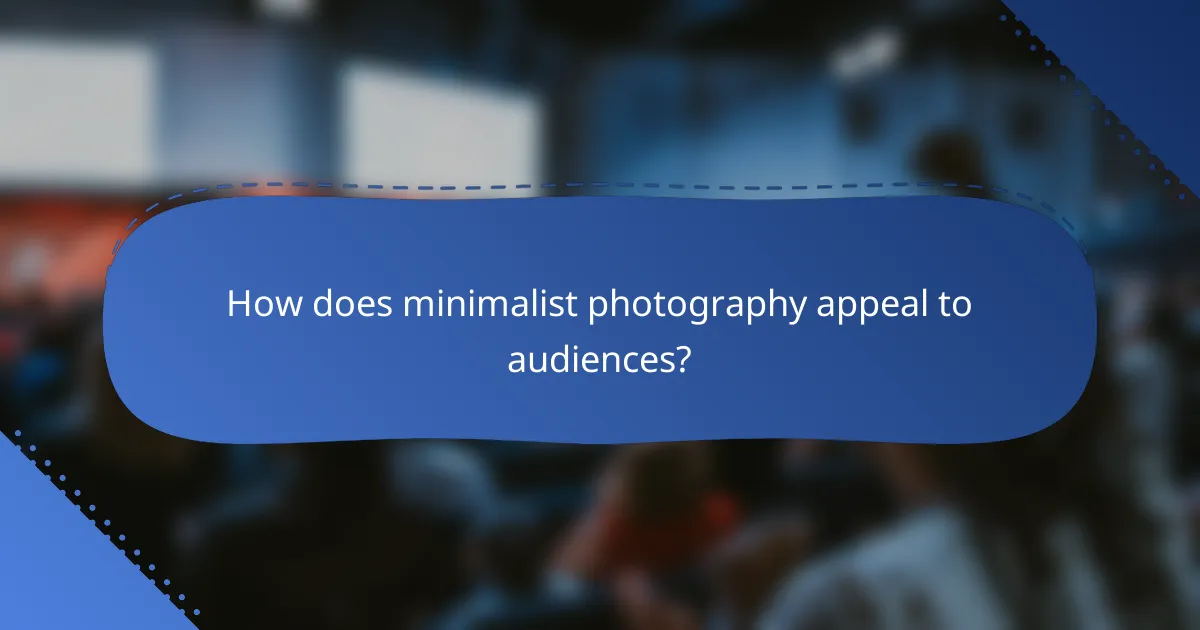Minimalism in photography emphasizes simplicity and clarity, allowing photographers to convey powerful messages through a focus on essential elements. By stripping away distractions, this approach highlights the beauty of overlooked details, whether in urban environments or natural settings. Key styles such as black and white minimalism, abstract minimalism, and architectural minimalism each offer unique techniques to create striking images that resonate with viewers.

How can minimalism enhance photography in urban environments?
Minimalism can significantly enhance photography in urban environments by stripping away distractions and focusing on essential elements. This approach allows photographers to convey powerful messages through simplicity, highlighting the beauty of often-overlooked details in cityscapes.
Focus on negative space
Negative space refers to the area surrounding the main subject in a photograph. By emphasizing negative space, photographers can create a sense of balance and draw attention to the subject itself, making it stand out against a less cluttered background. For urban photography, this might mean capturing a lone figure against a vast, empty street or an architectural feature surrounded by open sky.
To effectively use negative space, consider the composition carefully. Aim for a clean background that complements the subject without overwhelming it. Experiment with different angles and distances to find the most impactful arrangement.
Utilize monochromatic color schemes
Monochromatic color schemes involve using variations of a single color, which can create a cohesive and striking visual effect. In urban photography, this technique can highlight the textures and forms of buildings or streets while maintaining a unified aesthetic. For instance, capturing a cityscape in shades of gray can evoke a moody atmosphere.
When working with monochromatic schemes, pay attention to light and shadow to add depth. Consider shooting during different times of day to see how the color palette shifts, and adjust your settings accordingly to maintain the desired effect.
Incorporate geometric shapes
Geometric shapes can add a sense of structure and order to urban photography. By focusing on lines, angles, and forms, photographers can create visually compelling compositions that guide the viewer’s eye. For example, capturing a series of intersecting lines from buildings or roads can create a dynamic image.
To effectively incorporate geometric shapes, look for patterns in the architecture or layout of the urban environment. Use framing techniques to emphasize these shapes, and consider shooting from unique perspectives to highlight their impact.
Highlight textures and patterns
Textures and patterns can add depth and interest to urban photographs. By focusing on the surfaces of buildings, streets, or natural elements, photographers can create a tactile quality that invites viewers to engage with the image. For instance, capturing the roughness of a brick wall or the smoothness of glass can enhance the overall composition.
To highlight textures, use close-up shots and play with lighting to accentuate details. Look for contrasting materials within the urban landscape, as these can create striking visual effects when combined in a single frame.
Emphasize subject isolation
Subject isolation involves separating the main subject from its surroundings to create a stronger focal point. In urban photography, this can be achieved by using shallow depth of field or positioning the subject in a way that minimizes distractions. For example, photographing a person in a bustling city while blurring the background can convey a sense of solitude.
To effectively isolate your subject, experiment with different apertures and focal lengths. Consider using natural elements, such as trees or walls, to frame your subject and further enhance the isolation effect.

What are the key styles of minimalist photography?
Minimalist photography emphasizes simplicity and the use of minimal elements to convey a message or emotion. Key styles include black and white minimalism, abstract minimalism, nature minimalism, and architectural minimalism, each with distinct characteristics and techniques.
Black and white minimalism
Black and white minimalism focuses on the interplay of light and shadow, stripping away color to highlight shapes and textures. This style often enhances the emotional impact of an image, allowing viewers to concentrate on composition and form.
When practicing black and white minimalism, consider using high contrast to create striking images. Look for strong lines and patterns, and experiment with different lighting conditions to achieve the desired effect.
Abstract minimalism
Abstract minimalism removes recognizable subjects, focusing instead on shapes, colors, and patterns to evoke feelings or thoughts. This style often relies on geometric forms and can create a sense of balance and harmony.
To create compelling abstract minimalist images, use techniques such as close-ups, unusual angles, and intentional blurring. Aim for simplicity by limiting the number of elements in the frame, allowing the viewer’s imagination to fill in the gaps.
Nature minimalism
Nature minimalism highlights the beauty of natural elements by simplifying the composition to essential forms. This style often captures landscapes, flora, or fauna with a focus on negative space, allowing the subject to stand out.
When photographing nature in a minimalist style, seek out isolated subjects against uncluttered backgrounds. Use natural light during golden hours for softer shadows and enhanced colors, and consider using a wide aperture to create a shallow depth of field.
Architectural minimalism
Architectural minimalism emphasizes clean lines and open spaces in buildings and structures. This style showcases the beauty of design by removing distractions and focusing on the essence of architectural forms.
To capture architectural minimalism effectively, look for symmetry and geometric patterns. Utilize wide-angle lenses to emphasize space and depth, and shoot during times when natural light enhances the structure’s features. Avoid clutter in the frame to maintain a clean aesthetic.

What techniques are essential for minimalist photography?
Essential techniques for minimalist photography focus on simplicity and clarity. By emphasizing key elements and reducing distractions, photographers can create striking images that convey strong messages.
Use of shallow depth of field
Shallow depth of field isolates the subject from the background, drawing attention to the main focal point. This technique is achieved by using a wide aperture (like f/1.8 or f/2.8), which blurs out distracting elements and enhances the minimalist aesthetic.
When employing this technique, consider the distance between the subject and the background. A closer subject will yield a more pronounced blur, effectively simplifying the composition.
Intentional framing and composition
Intentional framing involves carefully selecting the arrangement of elements within the frame to highlight the subject. Using techniques like the rule of thirds can help position the subject in a way that enhances visual interest while maintaining simplicity.
Experiment with negative space, which is the area around the subject. This space can create a sense of balance and tranquility, reinforcing the minimalist approach.
Natural lighting optimization
Natural lighting plays a crucial role in minimalist photography, as it can enhance textures and create mood without added complexity. Shooting during golden hour—shortly after sunrise or before sunset—provides soft, warm light that complements minimalist compositions.
Be mindful of shadows and highlights; they can add depth but may also distract from the simplicity. Aim for even lighting to maintain a clean look in your photographs.
Post-processing for simplicity
Post-processing allows photographers to refine their minimalist images by eliminating distractions and enhancing key elements. Use editing software to adjust contrast, brightness, and saturation, ensuring the focus remains on the subject.
Consider applying a subtle vignette to draw attention inward or converting images to black and white for a timeless, uncluttered effect. Always strive for a final image that embodies simplicity and clarity.

What equipment is recommended for minimalist photography?
For minimalist photography, essential equipment includes prime lenses, lightweight camera bodies, and sturdy tripods. These tools help achieve sharp focus, ease of handling, and stability, which are crucial for capturing the essence of minimalism.
Prime lenses for sharp focus
Prime lenses are ideal for minimalist photography due to their fixed focal lengths, which often result in superior optical quality. They typically have wider apertures, allowing for better low-light performance and a shallower depth of field, emphasizing the subject against a blurred background.
When selecting a prime lens, consider options ranging from 35mm to 50mm for versatile framing. A 50mm f/1.8 lens is a popular choice for its affordability and sharpness, making it suitable for various minimalist compositions.
Lightweight camera bodies
Choosing a lightweight camera body enhances mobility, which is vital for capturing spontaneous minimalist scenes. Mirrorless cameras are often favored for their compact size and reduced weight compared to traditional DSLRs.
Look for models that offer good battery life and reliable performance in different lighting conditions. Brands like Sony and Fujifilm provide excellent lightweight options that maintain high image quality, making them suitable for minimalism-focused photography.
Tripods for stability
A sturdy tripod is essential for achieving stability in minimalist photography, especially in low-light situations or when using slow shutter speeds. Lightweight tripods made from materials like carbon fiber can provide the necessary support without adding significant weight to your gear.
When selecting a tripod, consider its maximum height, weight capacity, and ease of setup. A tripod with adjustable legs and a quick-release plate can enhance flexibility, allowing for various shooting angles and compositions.

How does minimalist photography appeal to audiences?
Minimalist photography captivates audiences by emphasizing simplicity and clarity, allowing viewers to focus on essential elements. This style often evokes strong emotions and encourages deeper contemplation by stripping away distractions.
Styles of Minimalist Photography
Minimalist photography encompasses various styles, each highlighting simplicity in unique ways. Common styles include abstract minimalism, where shapes and colors dominate, and environmental minimalism, which focuses on landscapes with vast, open spaces. Each style invites viewers to appreciate the beauty of simplicity.
Techniques in Minimalist Photography
Key techniques in minimalist photography involve careful composition and the use of negative space. Photographers often frame subjects against plain backgrounds to enhance their prominence. Additionally, utilizing natural light can create striking contrasts that emphasize minimalism.
Aesthetic Appeal of Minimalism
The aesthetic appeal of minimalist photography lies in its ability to convey powerful messages through simplicity. Clean lines, muted colors, and uncluttered scenes can evoke tranquility and introspection. This style often resonates with audiences seeking a break from the chaos of modern life.
